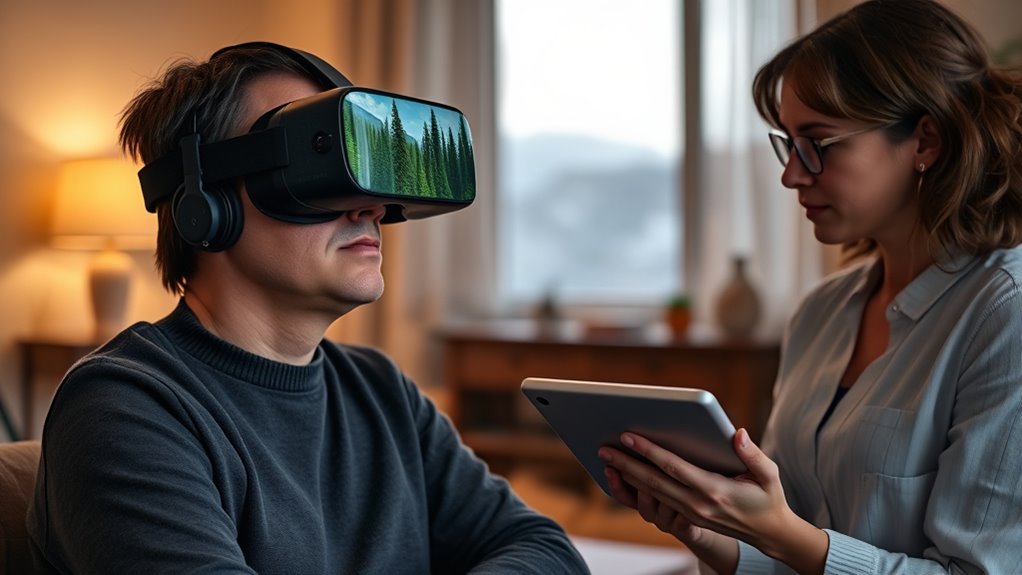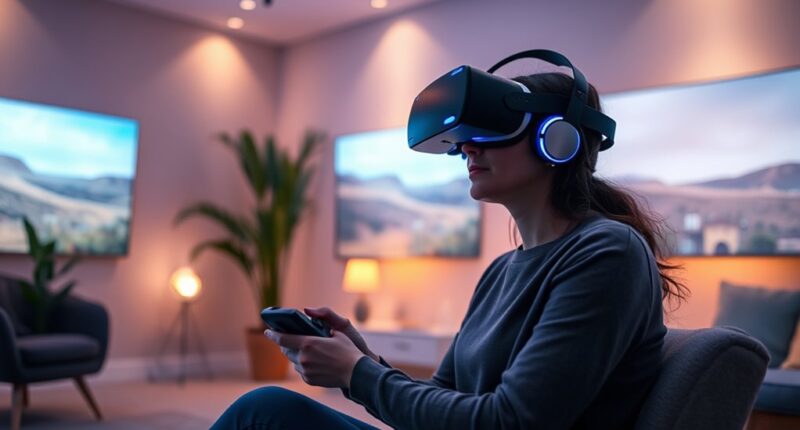Virtual reality therapy shows promise for PTSD by immersing you in realistic, controlled environments that help you confront and process traumatic memories safely. It engages your senses—sight, sound, and sometimes touch—to create a convincing experience, making exposure therapy more effective. With the guidance of a therapist, you can gradually face fears, reduce symptoms, and build resilience. If you keep exploring, you’ll discover how this innovative approach can transform your healing journey.
Key Takeaways
- VR therapy immerses patients in realistic virtual environments to effectively confront and process traumatic memories.
- Sensory engagement in VR enhances emotional responses, facilitating deeper trauma processing compared to traditional talk therapy.
- The controlled virtual setting allows gradual exposure, reducing overwhelming feelings and building coping skills safely.
- Repeated VR exposure can diminish trauma symptoms like flashbacks and hypervigilance over time.
- Customized virtual scenarios enable tailored treatment, improving engagement and therapeutic outcomes for PTSD patients.

Virtual reality therapy has emerged as a promising treatment for post-traumatic stress disorder (PTSD), offering a controlled and immersive environment that helps patients confront and process their traumatic memories. By harnessing advanced technology, it creates a simulated experience that feels real enough to evoke emotional and physiological responses, making exposure therapy more effective. This approach taps into sensory immersion, allowing you to fully engage your senses—sight, sound, and sometimes even touch—so you can confront your trauma in a safe, controlled setting.
In traditional exposure therapy, you might revisit traumatic memories gradually, often through talk therapy or imaginal exercises. Virtual reality amplifies this process by immersing you directly into a virtual environment that closely resembles your traumatic experience. For example, if you’re a combat veteran, you might find yourself in a virtual battlefield; if you’ve experienced a car accident, the simulation might include the sights and sounds of that event. This sensory immersion enhances the realism of the experience, helping your brain process trauma more effectively than just talking about it. It’s like stepping into the memory without the real-world risks, giving you the chance to confront fears head-on while maintaining control.
During a VR session, a trained therapist guides you through the simulated environment, gradually increasing or decreasing exposure based on your comfort level. This tailored approach ensures you’re not overwhelmed, but still challenged enough to desensitize your emotional response over time. The immersive nature of the experience helps your brain differentiate between the virtual environment and real life, reducing avoidance behaviors common in PTSD. It also allows you to practice coping skills in a safe setting, so you’re better prepared to handle triggers outside therapy.
The key benefit of sensory immersion in virtual reality therapy is how it engages your senses to evoke genuine emotional reactions. These reactions are essential for the therapeutic process because they help your brain process trauma more naturally. As you repeatedly face these virtual scenarios, your emotional responses tend to diminish, making real-world triggers less overwhelming. This combination of immersive exposure and controlled environment gives you a sense of mastery over your memories, reducing symptoms like flashbacks, hypervigilance, and anxiety. Additionally, the use of Vetted technology ensures the safety and effectiveness of these interventions, providing a reliable foundation for treatment.
Frequently Asked Questions
How Does VR Therapy Compare to Traditional PTSD Treatments?
You might wonder how VR therapy compares to traditional PTSD treatments. Virtual Reality offers immersive exposure therapy, allowing you to confront traumatic memories safely in a controlled environment. Unlike standard methods, VR can be tailored to your specific experiences, potentially reducing treatment time and increasing engagement. While traditional treatments rely on talk therapy, VR provides a unique, interactive approach that can enhance your healing process and improve outcomes.
What Are the Potential Side Effects of VR Therapy?
Potential side effects of VR therapy include cybersickness, which causes nausea or dizziness, and emotional distress, as reliving traumatic memories can be overwhelming. You might experience discomfort or heightened anxiety during or after sessions. While VR offers innovative intervention, it is crucial to monitor these symptoms closely, ensuring a safe and supportive space. Recognizing these risks helps you prepare and participate confidently in this cutting-edge treatment.
Can VR Therapy Be Used for All Types of PTSD?
You might wonder if VR therapy suits all PTSD types. While it shows promise for many, Virtual Reality Accessibility varies, and PTSD Symptom Diversity means it may not be ideal for everyone. Some individuals could find certain virtual environments triggering or overwhelming. Always consult a mental health professional to determine if VR therapy matches your specific needs, as personalized approaches often work best for diverse PTSD symptoms.
How Accessible Is VR Therapy for Rural or Underserved Populations?
You might think VR therapy is as rare as a unicorn, but it’s slowly becoming more accessible. For rural or underserved populations, telehealth infrastructure helps bridge the gap, allowing virtual sessions to reach remote areas. However, technological barriers like limited high-speed internet and lack of equipment still exist, making it challenging. While progress is ongoing, expanding access necessitates investments in infrastructure and tech support to guarantee everyone can benefit.
What Is the Typical Duration of a VR Therapy Program?
The typical duration of a VR therapy program varies depending on your needs, but it usually lasts between 6 to 12 weeks. Sessions often occur once or twice a week, with each lasting about 60 to 90 minutes. Your therapist will tailor the therapy duration and session frequency based on your progress and comfort level, ensuring the approach is personalized to help you effectively manage PTSD symptoms.
Conclusion
As you explore virtual reality therapy, remember that it’s a game-changer for PTSD treatment. With its immersive approach, you can confront your fears head-on and take control of your healing journey. While it’s still gaining ground, don’t count it out before seeing how it unfolds. Sometimes, you’ve got to take the plunge and trust that this new tool can open doors you never thought possible—like finding a lighthouse in a storm.










